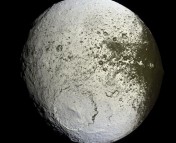- Paper Title: Why do Earth satellites stay up?
- Authors: S. Tremaine and T. Yavetz
- First Author’s Affiliation: Institute for Advanced Studies, Princeton, NJ
- Journal: Submitted to the American Journal of Physics
Overview
This paper seeks to provide a theoretical explanation for why gravitational perturbations do not disrupt the Keplerian orbits of satellites in Low Earth Orbit (LEO).
Background
Since the dawn of the Space Age, satellites have been an important component of the human experience. They have enabled us to study the cosmos and map our world; they help us communicate, and they let us locate ourselves wherever we are on Earth.
It came as a surprise to me, then, to learn that we do not yet understand precisely why our satellites stay up! Keplerian orbits, where a small object orbits a bigger one, are stable. However, Keplerian orbits assume both objects are point particles (or spherically symmetric), and moreover assume that there are no outside influences on the system. This is almost, but not quite, the situation on Earth. Satellites in Earth orbit face gravitational perturbations from the Moon and Sun. Moreover, the Earth is not a perfect sphere. It is an oblate spheroid, and the bits of the Earth that jut out past the spherical approximation also exert a gravitational perturbation on orbiting objects.
Taken together, these effects should disturb the orbits of satellites enough that they should crash. But they don’t. More than 1000 functioning satellites orbit the Earth, as do almost half a million pieces of debris. Why don’t they fall out of the sky? Spacecraft engineers have provided intuitive reasons. The authors of this paper sought to do more.
This work
The authors of this paper conducted a theoretical study of the non-Keplerian perturbations of the orbit. Using analytical techniques, they sought to quantify the effect of these perturbations and see how they interacted with each other. They adopted some simplifying assumptions: most importantly (and fairly reasonably), they assumed the orbit to be nearly circular, and the mass of the satellite to be negligible compared to the Earth and moon. They focus on satellites in Low-Earth Orbit (LEO), typically within 1000 km of the Earth’s surface.
They then treated the individual perturbations. First, they considered the perturbation due to the oblateness of the planet. This effect can be decomposed into different “multipole moments”, which are essentially corrections to the spherically symmetric approximation of the Earth’s gravitational field, to bring it more in line with reality. The strongest moment is the J2 quadrupole moment. The authors find that Keplerian orbits are stable to this perturbation; indeed, as we shall see, it actually has a stabilizing effect! On the other hand, the higher-order but much weaker J3 octupole moment is destabilizing to all orbits that are not polar or equatorial. The even weaker J4 moment is destabilizing to orbits within a narrow range of inclinations. The authors neglect the higher-level moments, as they are too weak to have significant effect.
The lunar gravitational perturbation is stable to near-equatorial orbits, but destabilizing otherwise. The solar perturbation, which acts in the same way as the stronger lunar perturbation, is not treated separately but should work the same.
The authors tested these analytical findings using a numerical computer simulation; the results were the same.
What happens when you add them all together? The stable planetary J2 quadrupole perturbation is so much stronger than all the other potentials that it stabilizes the satellite orbit against them. The only exception is near the so-called critical inclination of 63.43 degrees. This is an inclination known to have special properties in studies of satellite dynamics. At this inclination, it is possible for the quadrupole moment to become weak relative to the other effects. Hence, orbits near this inclination may become unstable.
Takeaway message
We now have a theoretical understanding of why the non-Keplerian perturbations affecting low Earth-orbiting satellites do not destabilize their orbits: The strongest of these perturbations stabilizes the orbits against the effects of the rest!
On a personal note, this paper shows that in this age of big data and numerical simulations, there is still a place for pen-and-paper calculations of the style of our forbearers. It also illustrates the depth of science: the theory of orbital mechanics has been well developed since Laplace in the early 19th century. And yet, 200 years later, we are still learning more about it. It just goes to show, there is a great deal of room in even old disciplines for exploration!




